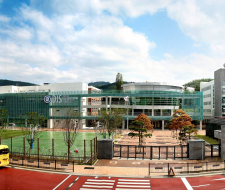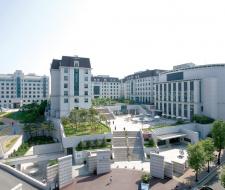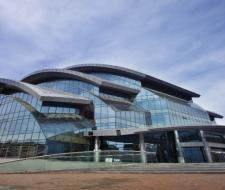Best boarding schools in South Korea 2026
- Boarding Schools in South Korea: An Overview for International Students
- Specialized Education in High Schools
- Tuition fees for boarding schools in South Korea
- Enrollment requirements
- Features of school education in South Korea
- Types of schools in South Korea
- Private boarding schools in South Korea
- Advantages and prospects of studying in boarding schools in South Korea
- How to choose the right private boarding school in South Korea?
- Literature and references
This content was developed and approved with active participation of Esther Diaz.
In the process of preparing the material, we referenced the following sources:
- https://en.wikipedia.org/wiki/Education_in_South_Korea
- https://www.hellokpop.com/news/korean-education-system-why-is-it-good-and-how-it-works/
-
 from 7050.00 $ / year
from 7050.00 $ / year -
 from 19500.00 $ / year
from 19500.00 $ / year
-
 Accreditations AACSB
Accreditations AACSB South KoreaDaejeonCurrently watching: 9from 6200.00 $ / semester
South KoreaDaejeonCurrently watching: 9from 6200.00 $ / semester -
 from 2399.00 $ / 2 weeks
from 2399.00 $ / 2 weeks -
 from 4384.00 $ / year
from 4384.00 $ / year -

 South KoreaDaejeonCurrently watching: 1from 7000.00 $ / year
South KoreaDaejeonCurrently watching: 1from 7000.00 $ / year -
 from 13143.00 $ / year
from 13143.00 $ / year -

-
 from 11000.00 $ / year
from 11000.00 $ / year -
 from 8391.00 $ / year
from 8391.00 $ / year
Today, South Korea occupies leading positions in the educational sphere along with China and Japan. By reaching the age of 2 to 3 years old, children begin to learn to read. System of preschool education stipulates studying math, English, and getting homework assignments. Naturally, when school education begins, the pupils are immediately actively involved in the learning process.
South Korea is home to over 40 international boarding schools, which invite local and foreign students to pursue education. International schools are required to ensure that the number of Korean citizens cannot exceed 30% of the total number of students who are enrolled.
International schools in Korea offer various study programs such as American, British, Canadian, Chinese, French, German, Japanese and International Baccalaureate.
Nowadays, South Korea is considered as one of the smartest countries, as the literacy rate of the population is very high. In recent decades, the government has been carefully monitoring the educational process, and this is bearing fruit. Confirmation of this is the fact that in South Korea the leaders in the field of high technology and automotive industry such as "Samsung", "LG", "Hyundai" were born and gained worldwide fame.
Alternative destinations
Boarding Schools in South Korea: An Overview for International Students
South Korea's boarding schools offer a distinctive educational experience, blending rigorous academics with cultural immersion. These institutions cater to students from around the world, providing a structured environment conducive to learning and personal growth.
Academic Year and Curriculum in South Korean Boarding Schools
The academic year consists of two semesters: March to July and late August to February, with breaks in between. Students typically begin primary education at age 6, receiving comprehensive instruction in Korean, mathematics, and other core subjects. English language education starts formally in the third grade, although foundational lessons begin earlier.
Secondary education continues the focus on academic discipline and includes a diverse curriculum encompassing:
-
Mathematics
-
Korean and English
-
Sciences
-
Social disciplines
-
Music and fine arts
Classes are generally held in the same room, with specialized spaces for subjects like physics and chemistry. The school week consists of six 45-minute lessons per day, Monday through Friday, with optional additional classes as needed.

What would you say is the most important when choosing a Spanish school?
This is the quality of support and work of the management, the opportunity to study at IB, the prestige of the school and the percentage of successful completion of the diploma stage of IB, recommendations for further universities. It is worth considering the national "recruitment" of campus students, opportunities for extracurricular development and activities, the availability of medical services and consultations, opportunities for language immersion. Is education at the chosen school based on the values you share? Is the school a close-knit community? Is academic support good?
Specialized Education in High Schools
High schools in South Korea offer specialized tracks in natural sciences, languages, arts, and more. The education is intensive, and students often engage in self-study and additional classes, allowing them to prepare for university entrance exams.
Top Boarding Schools in South Korea
- Branksome Hall Asia: An extension of Canada's Branksome Hall, located on Jeju Island, it offers the International Baccalaureate program. Catering to students from age three, the middle and high school programs are exclusively for girls, with a significant percentage of international students.
- Taejon Christian International School: Established in 1958 as Korea's first international IB school, TCIS in Daejeon emphasizes critical thinking and technological integration, accommodating foreign students in a family-like residential setting.
Tuition fees for boarding schools in South Korea
Tuition fees for international students vary based on factors such as school location, ranking, educational programs, and extracurricular activities. On average, costs range from $16,000 to $32,000 per academic year.
Enrollment requirements
Prospective students must obtain an educational visa and submit translated and notarized academic records, along with copies of their birth certificate and parents' passports. Most schools accept applications throughout the academic year, either on a competitive or general basis, depending on the institution.
Features of school education in South Korea
Education in South Korea combines high technology with traditional Eastern thinking. Great attention is paid to following rules and maintaining order. The secret to the success and productivity of South Korean students lies in the fact that they begin learning as early as the preschool level: by the age of 2-3, they are already learning to read, studying math, English, and receiving homework assignments.
Studying in elementary and middle schools is compulsory for all students, with a duration of education of 9 years. High schools offer pre-university program, lasting for three years, and designed for those who are interested in pursuing education at a university. According to statistics, almost 98% of students decide on entering university. Secondary education in South Korea involves heavy workloads: teenagers attend additional private lessons, engage in independent work, and spend a total of up to 16 hours a day studying. This helps students achieve high results.
Elementary, middle, and high schools are located in separate buildings and are not connected to each other organizationally.
A unique aspect of the South Korean education system is that teachers are frequently transferred from one school to another. This ensures that they can work with different children, preventing the emergence of "weak" and "strong" schools.
Students are prohibited from using mobile phones during lessons: they leave all their devices in designated compartments before classes begin.
Types of schools in South Korea
Schools in South Korea are classified into public and private. Private schools charge fees for studying. Generally, all secondary educational institutions can be classified into three types:
- Local,
- Foreign,
- International.
The South Korean Ministry of Education has developed a national curriculum that all schools, including private ones, are required to follow. Independent (autonomous) educational institutions often adjust their curriculum and set their own admission criteria, thereby increasing competition.
Private boarding schools in South Korea
Compared to public schools, private ones have more state-of-the-art facilities and equipment. No matter what school type a student chooses, the quality of education is high everywhere. South Korea is not distinguished with a great number of educational institutions with a full board basis, which stipulates a residential campus, social-medical infrastructure and provision of food for the child. Most of the boarding houses are located in the major cities of the country, the most top and famous - in Seoul. Children, who represent more than 20 different nationalities, study in boarding schools in South Korea.
Private boarding schools are classified in several types:
- private boarding schools - preparation for admission to the top universities of the world,
- specialized boarding schools - sports, scientific, creative, etc.,
- religious boarding schools - historically founded by religious groups, but now accept students of all religions and denominations.
Most boarding schools are based on American or British curricula - IB, American Curriculum, Advanced Placement, UK National Curriculum, GCSE, A-Levels, BTEC, etc. All subjects are taught in English, but Korean is always included in the program as an optional subject. Usually, teachers in such schools are native speakers with experience of working in the UK or USA.
The advantage of private schools is their striving to make learning comfortable, effective and interesting: for this purpose, the latest equipment and modern technologies, laboratories, thematic studios, unique sports facilities are used. Also students are provided with hot meals on a daily basis. In most schools, a transfer is organized from home to school and back by their own bus.
Advantages and prospects of studying in boarding schools in South Korea
- High-quality education.
- Modern and diverse technical equipment.
- Strong academic focus on IT, natural sciences, and exact sciences.
- Well-developed infrastructure.
- High chance of admission to South Korean or foreign universities.
- High level of preparation and self-discipline, allowing students to compete equally with local applicants.
- Financial assistance for higher education.
- Benefits in obtaining scholarships, while studying at a university.
- Safety and a high standard of living.
How to choose the right private boarding school in South Korea?
When selecting an educational institution in South Korea, it is important to consider:
- The availability of accreditation and an educational license,
- The school's prestige,
- The diploma awarded upon graduation (ideally, it should be of an international standard),
- The teaching methods and additional subjects offered,
- The teaching staff,
- The school's building and infrastructure,
- The organization of additional services such as accommodation, meals, transportation, and medical care.
Advantages and disadvantages of English schools
| Advantages | Disadvantages |
|---|---|
| The opportunity to enter the best universities in England, USA, Canada, Switzerland, Europe, the world | Expensive |
| High quality of education and academic standards | Strong workload |
| Perfect English after graduation | The need to change the social environment; it takes time to adapt |
| Useful contacts | The difficulty of choosing the most suitable school for the child, requires a qualified specialist |
Top 35 best schools in the USA - 2026 Smapse rankings
| 1 | North Broward Preparatory School |
| 2 | Phillips Academy Andover |
| 3 | The Storm King School New York |
| 4 | Red Bank Catholic High School |
| 5 | Windermere Preparatory School |
| 6 | Shattuck St Mary's School |
| 7 | Cheshire Academy |
| 8 | Cate School |
| 9 | Ross School |
| 10 | Deerfield Academy |
| 11 | The Village School |
| 12 | Amerigo Los Angeles – Bishop Montgomery High School |
| 13 | Webb Schools |
| 14 | Kent School USA |
| 15 | The Winchendon School |
| 16 | Darlington School |
| 17 | Marian Catholic High School Amerigo Education |
| 18 | Grier School |
| 19 | The MacDuffie School |
| 20 | CATS Academy Boston |
| 21 | The Cambridge School of Weston |
| 22 | Milton Academy |
| 23 | Amerigo Education Napa Valley |
| 24 | American Hebrew Academy |
| 25 | Northfield Mount Hermon School |
| 26 | Mater Dei Catholic High School San Diego Amerigo Education |
| 27 | American University Preparatory School Los Angeles |
| 28 | Webb Schools |
| 29 | Kent School USA |
| 30 | Groton School |
| 31 | Maine Central Institute |
| 32 | The Lawrenceville School |
| 33 | Grand River Academy Ohio |
| 34 | Saint John Paul II Academy |
| 35 | Chicago North Shore |
Top 14 best schools in Switzerland 2026
| 1 | College Du Leman |
| 2 | St. Georges School Montreux |
| 3 | Institut Monte Rosa |
| 4 | Lyceum Alpinum Zuoz |
| 5 | Saint-Charles Collège et Lycée |
| 6 | Leysin American School |
| 7 | Hochalpines Institut Ftan AG High Alpine |
| 8 | Aiglon College Switzerland |
| 9 | Institut Le Rosey School |
| 10 | Institut Montana Zugerberg |
| 11 | Champittet College |
| 12 | Brillantmont International School |
| 13 | Surval Montreux |
| 14 | Ecole Pre Fleuri |
